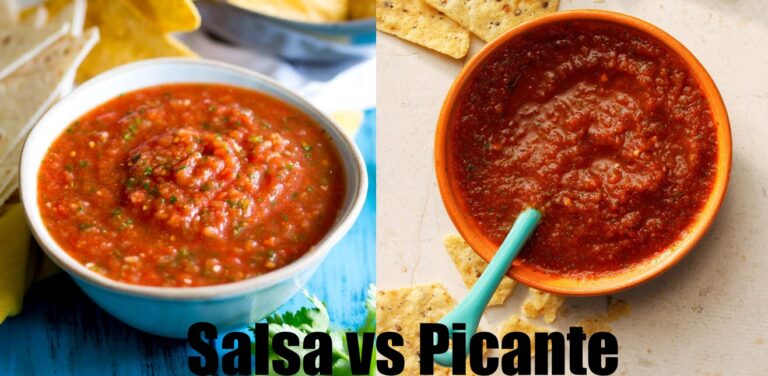When it comes to Latin American cuisine, salsa and picante are two terms that often come up, yet many people may not fully understand the differences that set them apart. Both are popular condiments that add flavor and zest to a variety of dishes, making them staples in many households and restaurants. However, they each have unique characteristics, ingredients, and culinary purposes that are worth exploring to appreciate their individual contributions to food.
Let’s take a look at the differences between the two!
What is Salsa?
Salsa is a Spanish word that translates to “sauce” in English. It is a versatile condiment made from a variety of chopped vegetables, fruits, herbs, and spices.
The exact ingredients used in salsa can vary greatly depending on the type of salsa and the region it originates from, but common components include tomatoes, onions, cilantro, lime juice, chili peppers and garlic.
Salsa comes in different textures ranging from chunky to smooth and has a vibrant range of flavors that can be mild or spicy.
Types of Salsa
There are numerous types of salsas originating from various Latin American countries including Mexico, Colombia, Peru, and Cuba. Some popular types include:
- Salsa roja (red salsa): made with tomatoes, onions, and chili peppers
- Salsa verde (green salsa): made with tomatillos, cilantro, and green chili peppers
- Pico de gallo: a fresh chopped salsa made with tomatoes, onions, jalapenos, cilantro and lime juice
Regardless of the type, salsas are typically used as a topping or dip for dishes such as tacos, nachos, quesadillas or as a condiment for meats and seafood.
What is Picante?
Picante translates to “spicy” in Spanish and refers to any spicy sauce or seasoning. It is often associated with Mexican cuisine but can also be found in other Latin American countries.
Unlike salsa, picante is typically a cooked sauce made from dried chili peppers, vinegar, spices and sometimes tomatoes. It has a thin consistency and packs a punch of heat.
Types of Picante
Similar to salsa, there are many variations of picante depending on the specific ingredients used. Some popular types include:
- Hot sauce: typically made with hot peppers, vinegar, and salt
- Adobo: a paste-like seasoning made from ground chili peppers, garlic, oregano and cumin
- Mojo: a marinade or dipping sauce made with garlic, citrus juices and herbs
Picante can be used in cooking for flavoring, as a marinade or added to dishes for an extra kick of heat.
So, What’s the Difference?
The main difference between salsa and picante lies in their ingredients and preparation. Salsa is typically made with fresh, raw ingredients while picante often uses dried or cooked components.
Additionally, salsa tends to have a chunky texture with a variety of flavors, while picante is more liquid and focuses on adding spice.
In terms of usage, salsas are often used as dips or toppings for dishes, whereas picante can be used as a seasoning or marinade in cooking. However, both are versatile condiments that can add flavor and complexity to any dish.
Home Made, Craft, and Major Brand Differences
Salsa and picante are available in a variety of forms, ranging from homemade to store-bought varieties. Although the fundamental techniques for preparing these condiments are similar, there are notable differences between them.
- Homemade salsas and picantes tend to have a fresher taste as they are made with fresh ingredients and can be customized according to personal preferences.
- Craft brands often use high-quality, locally sourced ingredients and may have unique flavors or combinations of traditional recipes. You can also discover much spicier variants if you enjoy intense heat. An excellent example of that are salsas such as the 7 Pot Primo Salsa from Mikey V’s Foods.
- Major brand salsas and picantes are often mass-produced using standardized recipes and may contain preservatives for longer shelf life. However, they offer convenience and consistency in flavor.
Ultimately, the best choice depends on individual tastes and needs. Homemade versions provide flexibility in flavor while craft brands offer variety, but major brands offer convenience for those who prefer consistent flavors. No matter which type you choose, both salsa and picante are flavorful
Conclusion
In summary, salsa and picante may share some similarities in their origins and use of Latin American flavors, but they are distinct condiments with unique characteristics. Whether you prefer the fresh tanginess of salsa or the fiery heat of picante, both add a flavorful kick to any dish. So next time you’re enjoying your favorite Mexican meal, take a moment to appreciate the differences between these two delicious condiments!
Keep exploring different types and variations of salsa and picante to discover new flavor combinations and add some Latin American flair to your meals.
Keep an eye for more news & updates on VentsBuzz.Com!
